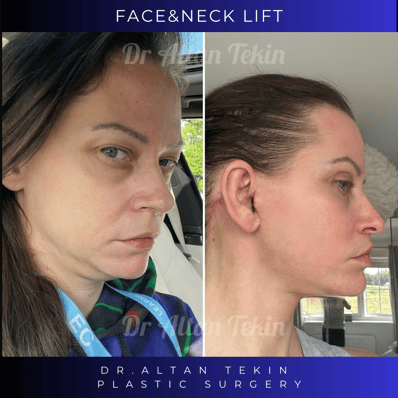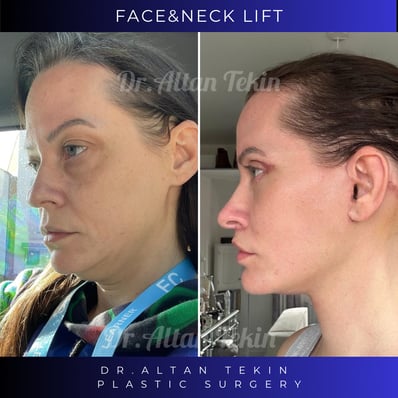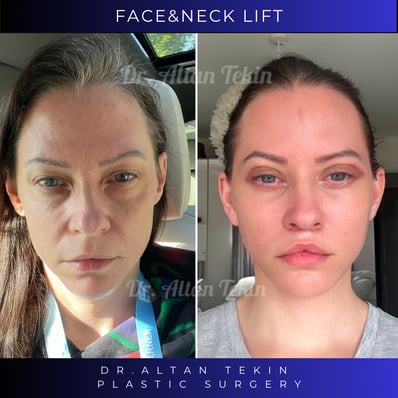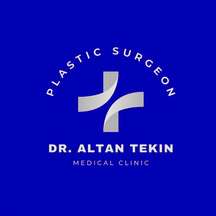Face Lift Surgery



What is Face-Lift?
Face lift surgery is a plastic surgery procedure that corrects the signs of aging in the face and neck area. The aim of the surgery is to tighten the skin, stretch the facial muscles and give the facial features a younger, fresh and natural appearance. Facelift surgery is aimed at eliminating problems such as sagging, wrinkles and looseness due to the aging process.
The following procedures are usually performed during facelift surgery:
Skin Tightening: The skin surface is tightened, excess skin can be removed and stretched.
Muscle Stretching: Facial muscles are stretched and tightened. This makes facial features look younger.
Adipose Tissue Arrangement: Fat tissue can be removed or reshaped when necessary during surgery.
Facial Surgery Techniques: Different techniques can be used, such as traditional face lift, SMAS (Subcutaneous Aponeurosis System) techniques, minimally invasive methods. Which method to use may vary depending on the patient's needs and the surgeon's preferences.
As a result of facelift surgery, a younger, fresher and lifted appearance is obtained. However, results may differ from person to person and signs of aging may slowly return over the course of the surgery.
Facelift surgery is usually performed under general anesthesia or sedation. Symptoms such as swelling, bruising and mild pain are normal during the post-operative recovery period. The recovery process may vary depending on the general health condition of the person, the complexity of the surgery and the techniques used.
If you are considering facelift surgery, it is important to meet with a plastic surgeon and discuss your expectations in detail, as well as the potential risks and consequences of the surgery.


What are Face-Lift Surgery Techniques?
There are different techniques of face lift surgery. These techniques may vary according to the patient's needs, skin structure, and the surgeon's preferences. Here are some commonly used facelift surgery techniques:
Traditional Face Lift: This technique is generally preferred for patients who experience more sagging and wrinkles. The skin incisions extend from the back of the ear to the hairline and may also include a section that extends to the back of the face. The facial muscles and underlying tissue (SMAS) are also stretched. With this technique, sagging in the upper, middle and lower parts of the face is corrected.
SMAS Face Lift (SMAS Face Lift): SMAS (Subcutaneous Aponeurosis System) techniques target a layer of facial muscle and connective tissue. This technique aims to achieve more natural and long-lasting results. With SMAS stretching, the skin is fixed to deeper and more durable tissue.
Minimally Invasive Face Lift: These techniques aim to tighten the face using a less invasive approach. It includes endoscopic techniques or methods that work with small incisions. These techniques are generally preferred to correct lighter sagging and the recovery time is shorter.
Lower Face Lift: This technique usually targets sagging and wrinkles in the jaw line and neck area. Lower face lift surgery is used to correct sagging in the areas between the chin and neck.
Mid Face Lift: A mid face lift targets the area between the cheekbones and the sides of the nose. This technique aims to correct sagging and wrinkles in the mid-face area.
Neck Lift: This technique is often used to correct sagging and fat deposits in the neck area. Neck lift can be performed together with or separately from facelift surgery.
It is important to consult with a plastic surgeon to determine which facelift surgery technique is best suited for your situation. Considering your skin structure, signs of aging and your wishes, the technique that can achieve the best result for you should be determined.


What should be considered after the Face-Lift operation?
After face lift surgery, there are some important points that you should pay attention to in order to preserve the result of the surgery, speed up the healing process and reduce the risk of complications. Here are some general recommendations that you should pay attention to after facelift surgery:
Rest and Recovery: Get adequate rest in the post-operative period. Avoid heavy physical activities and move as your doctor recommends.
Cold Application: You can apply an ice pack or cold compress in the first days to reduce swelling and bruising after the surgery.
Suture Care: If sutures have been used, maintain suture care as recommended by your doctor. Be aware of when the stitches will be removed.
Head Position: You can reduce swelling and bruising by keeping your head elevated for the first few days.
Special Bandage or Bra: Use the special bandage or bra as recommended by your doctor. This can support the healing process.
Medication Use: Use the painkillers and medications recommended by your doctor regularly. This can help you keep the pain under control.
Nutrition and Hydration: Pay attention to a healthy diet and make sure you drink enough water. This can support the healing process.
Smoking and Alcohol: Limit or quit smoking and alcohol use in the post-operative period if possible. This can positively affect the healing process.
Doctor Controls: Do not forget to go to the doctor's controls regularly after the surgery. Your doctor will monitor your recovery and make recommendations if needed.
Sun Protection: Use sunscreen and a hat to protect yourself from sunlight after surgery.
Psychological Support: Emotional difficulties may be experienced after the surgery. It is important to seek psychological support when necessary.
Make-up and Skin Care: You can start using make-up and skin care products at the time recommended by your doctor.
Although there is usually a rapid recovery after facelift surgery, every patient is different and the recovery process may vary. Strictly following your doctor's recommendations will help you to preserve the outcome of the surgery in the best way possible and to minimize possible risks.


Your facelift recovery explained from Day 1 to Day 30
Facelift recovery Week 1
During this time, you must make sure you are following postoperative incision care and keeping them clean to prevent infection.
Day 1. After surgery, you may feel unsteady and sleepy. You should have set up support from family and friends to drive you home and care for you on your first night home. Day one is usually when you most need pain medication to stay on top of discomfort.
Day 2. Your surgeon will schedule a follow-up visit around this time. They will remove or change your surgical dressings and evaluate your incisions and swelling. If everything looks good and normal, the surgeon will re-dress the area, review postoperative care once again and send you on your way.
Day 3. Rest is recommended for this day, but you should start to feel better and want to move around some. Bruising and swelling usually reach their height around day 3 and 4, but both will likely be present for several additional weeks. Continue to take medication if you experience discomfort.
Days 4-6. By this time, most people no longer need prescription pain medication. You should start to see the swelling go down. You should also start feeling more comfortable moving about. Doing light housework is often permitted if you feel well enough.
Facelift recovery Week 2
Days 7-14. During this week you’ll likely still have some swelling and bruising around the affected areas. Swelling and bruising can also cause some people to experience some numbness, tingling and tightness. These are all common occurrences after a facelift and should not cause concern. At the end of the second week post-surgery, many people are feeling like themselves and ready to return to work and begin doing light activities like walking.
Facelift recovery Weeks 3 and 4
Days 15-30. Removal of your sutures may occur anywhere from the end of week one to week three and depend on your particular procedure as well as your healing process. At weeks 3 and 4, you still may have some residual swelling and tightness, but for the most part, will start looking and feeling much better. Here is where patients often begin to see real improvements in their facial contour. By this time, you can get back to exercising and enjoying activities without people noticing much, if any, outward signs of your procedure. Incision sites will have a pinkish-red hue but this should fade with time.
What to expect after Day 30
After the one-month postoperative mark, you should be back to doing normal activities and enjoying life with your new look. It can take up to one year for very minor swelling, bruising, tightness and numbness to reside, but those typically are only noticeable to you.
Keep in mind that the above timeframes only represent very general timeframes. Everyone will have a unique experience, and you should always follow the directions provided by your plastic surgeon. People who do their research, take the necessary precautions and follow their surgeon’s post-op care instructions usually have the easiest recoveries and the best outcomes. It's important to communicate with your surgeon throughout the entire process. Ask questions and let them know if you are experiencing any symptoms that you feel are out of the ordinary.
FACELIFTSAFETY & RISKS
The list of risks below is indicative of the more common complications but is not meant to be exhaustive. Complication rates tabulated as a percentage from over 2,000 audited facelifts are quoted below with each risk factor.
Bleeding (0.6%). Bleeding beneath the skin from small capillaries can cause excessive bruising to collect (haematoma) which may require surgical treatment. The most common time for it to arise is within the first twelve hours after surgery when you will be in hospital. It normally does not influence the ultimate outcome of the operation.
Infection (0.1% requiring intravenous antibiotics). Infection is uncommon after facelift surgery. Prophylactic antibiotics are routinely given during surgery and for 5 days after to reduce the risk. Only 2 patients out of the last 2,000 have required intravenous antibiotic treatment (0.1%).
Temporary numbness in the area of surgery is normal and to be expected where the skin was lifted. This occurs after any type of surgery where skin is lifted from the underlying fat (e.g. caesarean section, hernia repair, appendectomy, breast lump removal etc). The area of numbness is less following Deep Plane facelifting compared to other SMAS type lifts as less skin is lifted from the underlying tissue. Sensation recovers spontaneously as the nerves grow back with the appreciation of soft sensation returning by 2-3 months however full sensation may take 12-18 months to recover which it does in 96-97% of patients. As sensation recovers you may notice some tingling or pins and needles which is normal and a positive sign of recovery.
Temporary hair loss in the region of the lower temple is seen occasionally in smokers although this recovers over a period of three to six months. No patient of Mr Grover’s in the past 2,000 facelifts has needed any surgical correction or intervention for hair loss of any sort.
The scars are normally fine and well hidden, but in some individuals a scar may show a tendency to thicken after 6-12 weeks as their body is prone to this type of healing despite the incision being stitched without tension. These “hypertrophic” scars can be improved by appropriate treatment such as applying silicone containing creams (Dermatix / Kelocote) or steroid injections. Four patients in the past 2,000 have needed steroid injections for a hypertrophic scar, all were located behind the ear and therefore reassuringly, were not visible. No patients treated over the last 20 year period required surgical intervention for hypertrophic scarring. Crucially, Mr Grover avoids making any scar in the temple in front of the hairline which avoids the key area of visibility that concerns most patients after facelifting.
Nerve Weakness. The Facial nerve is responsible for moving the muscles of the face and it lies deep below the SMAS layer. Care is taken to avoid this during a facelift. The nerve can be bruised due to the surgical dissection or from swelling in adjacent tissues causing a temporary weakness of the muscles of the lip, mouth, or eyebrow. This recovers well as there was no direct injury to the facial nerve itself. 6 patients in the past 2,000 have had this temporary issue and all recovered fully. No patient in Rajiv Grover’s practice has ever suffered a permanent injury with weakness to the Facial Nerve since he opened his practice over two decades ago in 2001.
Wound healing in the face is generally very quick and reliable. Occasionally a slow healing wound may be seen. This is usually behind the ear since the skin there is most fragile. Such problems are, fortunately, very uncommon but are known to be more likely in smokers. No patient has required surgical treatment for a wound healing issue in the past 2,000 facelifts under Mr Grover.
Revision Rate (0.8%). However carefully surgery is performed the healing process and each patient’s biology can influence the outcome. As a consequence, patients can occasionally require further surgery to improve a scar or improve the result of a facelift where skin quality has meant that a small area of loose skin has reappeared. In over 2,000 facelifts Rajiv’s revision rate is less than 1% with only 16 patients requiring surgery for any reason (0.8%).
FACE & NECK LIFT
RECOVERY
Pre-operative checklist timeline
One Month Before Surgery
Stop drinking alcohol as this has a blood thinning effect. Avoiding alcohol will reduce your risk of bruising and swelling following surgery which enhances recovery.
Two Weeks Before Surgery
Stop all Vitamins and supplements as well as Aspirin and non-steroidal pain killers such as Brufen, Nurofen, and Voltarol etc. Again, by avoiding these you reduce your risk of bleeding and bruising with surgery. Please note – so potent is the risk of bleeding with these drugs that Mr altan has cancelled patients before surgery if they have neglected to omit blood thinners for two weeks.
One Week Before Surgery
If you colour your hair, please do so approximately a week before surgery. You will be able to colour again about 4 weeks after surgery.
Shopping List Before Facelift Surgery:
“V” Pillow from John Lewis. These help you to sleep slightly elevated after surgery and reduce the chance of turning to the side.
“Simple” facial wipes. These not only help clean the face but also contain moisturiser.
Comfortable front fastening garments to wear after surgery (cardigans or zip up tops). This will allow removal without going over the head which could risk catching on your ears.
Fan to keep the room cool post-surgery especially if your surgery is in the summer.
Subscription to Netflix along with selection of books and magazines
Stock up on food and consider some ready meals.
Please do not use neck travel pillows (as used on airline flights). These cause pressure on the neck which is best avoided.
Day before Surgery
Stock up on plenty of ice in the freezer so that you have this readily available following your return from the hospital. It will be needed for the cooling flannels which Mr Grover will recommend once you are back home. How these are applied will be explained to you in hospital before you leave by Mr Grover.
Prepare your overnight bag (two nights). Nightwear will be provided but you might prefer your own pyjamas. You will need a bathroom bag with toiletries and “Simple” facial wipes. Loose comfortable clothes for two days (tops should be front fastening). Laptop or iPad for entertainment and your mobile phone plus charger.
Keep yourself well hydrated during the day and up to the time you sleep (i.e. before midnight) – drink extra water the day and evening before surgery so the period of nil by mouth after midnight does not dehydrate you.
Evening before Surgery
Wash your hair thoroughly using your regular shampoo so that your hair and scalp are squeaky clean before surgery.
Remove all makeup
Please remove jewellery including bracelets (esp. Cartier love bracelets – the hospital do not have the appropriate screwdriver to release these for you and there should be no panic in the morning). You may wear your wedding ring.
Please remember you must not eat or drink anything at all after midnight the night before surgery regardless of what anyone tells you.
Morning of Surgery
Come to the hospital makeup free. Makeup on the skin at the time of surgery is an unnecessary infection risk. Mr Altan will clean your face prior to surgery but still please avoid make up and especially eye makeup as this can lead to granules of mascara or eyeliner falling into the eye whilst you are asleep potentially risking a corneal abrasion.
Frequently asked questions
Is having a facelift painful?
Pain after a deep plane facelift is usually minimal because the deeper layer (SMAS) is lifted after dividing its underlying attachments (retaining ligaments) which means the procedure is performed without the tension. This contrasts with older type SMAS facelifts where underlying release was limited which meant that tension in the face was more likely. Most deep plane facelift patients will say after surgery that it was not painful although some have a tight feeling in the neck initially which improves over the first few days as the swelling settles, usually resolving by a month.
Do I need to smoking before facelift surgery?
Most definitely yes. Nicotine within cigarette smoke is a potent vasoconstrictor (i.e. makes blood vessels constrict) which therefore reduces blood supply in the skin and increases the risk of infection and wound healing problems. Mr Altan will recommend having no nicotine for a minimum of two months before surgery and one month after. This includes cigarettes, cigars, nicotine inhaler, nicotine patches, nicotine chewing gum and vaping.
How long does the facelift does?
Facelifting puts the ageing clock back by 8-10 years on average, but of course, cannot stop it from ticking. Ten years after your facelift you will certainly have aged but will still look younger than if you did not have the surgery. Please remember that ageing is not a linear process but can occur in spurts which follow periods of stress, illness, or weight loss. Consequently, no surgeon can honestly predict exactly how long the improvement will last which is why the figure of 8-10 years is quoted as an honest average. There are some patients for whom the rejuvenation can be 15 years but equally some for whom it is less than the average because they may have suffered an ageing spurt. Mr Altan exclusively performs the Deep Plane Facelift technique which has been shown to have a greater longevity than other SMAS facelifting techniques.
Can I have a facelift without neck lift?
The key to deep plane facelifting is repositioning the deeper layer (SMAS) without tension. This requires releasing the underlying attachments of the SMAS to its retaining ligaments. The SMAS is continuous with the platysma muscle in the neck which is the deeper layer of the neck that supports its shape. If a deep plane facelift is correctly performed and the retaining ligaments are released, then moving the SMAS automatically moves the platysma in the neck at the same time. In general, if a deep plane facelift is being performed it will automatically lift the neck so the two are inevitably a combined procedure.
I am planning to lose weight, should I do so before having a facelift?
The requirements for a successful facelift are that there has been gravitational descent and laxity within the soft tissues. Losing weight impacts the face as fat is lost from under the skin (superficial fat compartment). This can exaggerate the effects of gravitational descent as the face empties and also increases laxity. For both reasons losing weight before facelift surgery can help make the operation more effective. Conversely to loose significant weight after surgery is unhelpful and may cause some skin relaxation. If you are planning to lose weight please do it before facelift surgery and definitely not afterwards.
